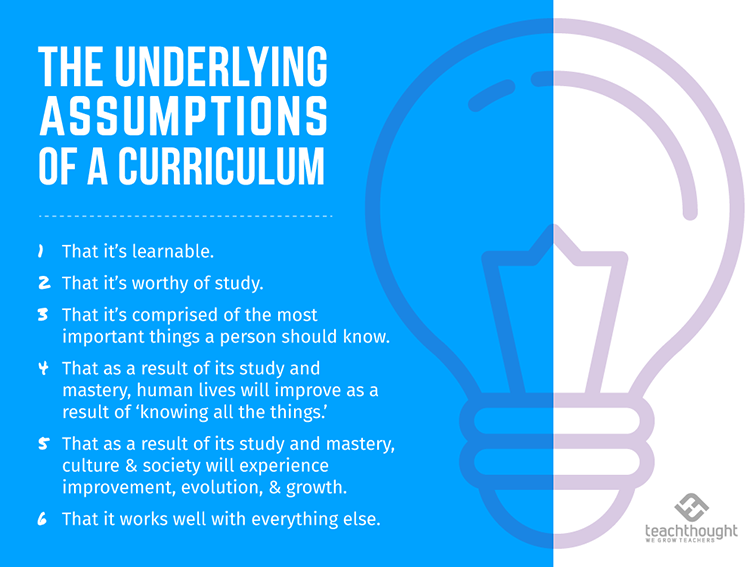
What Is Are The Underlying Assumptions of a Curriculum?
by Terry Heick
There are ideas and then there are ideas between ideas.
That is, the spaces between ideas can be pregnant with ideas of their own in the same way that there are stars and then there are spaces between the stars. And these spaces matter because they’re dark and dark (and its absence) characterizes light.
Okay, how about this: Every reality has factors. Every effect has a cause. Every data point has a context. You can separate these relationships in a temporary kind of singularity in order to examine them, but in doing so risk losing the thing itself because the thing doesn’t just have a context but only exists in a context.
We may fail to recognize these factors and causes and contexts, but they’re there. We may fail to extract the right lessons from these factors and realities and causes and effects and contexts and data, but they’re there, ready to be extracted.
And it’s not just about contexts and relationships. There are distinctions here too—nuanced distinctions that are not minor. The difference, for example, between causation and correlation. The difference between cause and effect but also the reality that it’s all relative (context) and recursive and non-linear. One thing ends and another begins and one causes the other and defines the other and depends on the other but are also entirely separate.
Which brings us to underlying assumptions.
That there are underlying assumptions that we ‘bring’ to a thought or decision may be more interesting than examining one set of underlying assumptions themselves, but we’re here for innovation in education, not epistemology.
Note: These aren’t in any sort of order because sometimes one needs another for context so I couldn’t, for example, leave #2 for last (as the most important) because it helped flesh out the rest and I thought #1 should be first even though it may not be the most important.
The Assumptions And Characteristics Of A Curriculum
I. That it’s learnable.
This one should be obvious.
II. That it’s worth learning.
This is hugely subjective but let’s just assume we mean ‘worth learning’ and knowing for most students. Again–if not, why study it? And this may be the single most important underlying assumption of any given curriculum.
Are these things both knowable and worth knowing?
III. That it’s comprised of the most important things a person should know.
After clarifying that things are both knowable and worth knowing, a third underlying assumption is that it’s comprised of the most important things that are knowable and worth knowing.
Whether concepts, skills, competencies, ideas, etc.–it doesn’t make much sense for students to study less important things while more important things go unstudied. (Obviously, this is subjective but there’s an art and a science to education and this is a big part of the art. Perhaps the biggest.)
If we live in a society where pottery is important, it would make sense to ‘teach pottery.’ If pottery were only somewhat relevant and ‘nice to know,’ while it may ‘feel good’ to teach pottery, the curriculum immediately becomes less useful and valid–and even destructive on a cultural level.
By teaching pottery we’re not teaching something else.
IV. That as a result of its study and mastery, human lives will improve as a result of ‘knowing all the things.’
Another underlying assumption of a curriculum is that there’s something valuable we’ll know and be able to do as a result of its mastery–and more importantly, that those who study it will both be able to (as a matter of cognitive transfer) and tend to (as a matter of habits and behavior) use what has been learned in a way that makes their life better.
This should, most immediately, result in personal change.
V. That as a result of its study and mastery, culture and society will experience improvement, evolution, and growth.
Personal change eventually should lead to social change. If societies aren’t changing, that implies either that they don’t need changing or education cannot change them. The former is unlikely and the latter is unacceptable.
And note, the benefit of a curriculum cannot be future-heavy as we seek to ‘get kids ready for the jobs of tomorrow.’
If the value of knowledge is primarily academic or primarily speculative, it is a worthless curriculum and will fail to resonate with students in the world they live in–and need knowledge and skills in–today.
VI. That it ‘plays nicely’ with the system it’s embedded within
Another underlying assumption of a given curriculum should be that, as a ‘part,’ it is aligned or alignable with other parts and is or can easily become parallel with the other ‘bits and pieces’ of education.
This means that existing infrastructure–from buildings and technology and textbooks and assessment forms to teachers and instructional strategies and school and district hierarchies–should be curriculum-friendly or that we should revise the curriculum to be infrastructure-friendly.
(You can read more about this idea in the Updating the Gears of Education.)
If we designed school backward from what it already does well, rather than insisting it does everything all the time for all students, is that smart design or ‘lowering our standards’?
I’ll add more of these underlying assumptions’ as they come to mind.